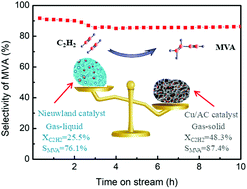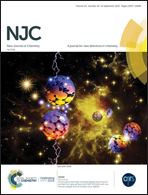Gas–solid acetylene dimerization over copper-based catalysts
Abstract
Acetylene dimerization is an important step in an acetylene-based process for chloroprene production, and the traditional catalyst for this transformation is the Nieuwland catalyst in a bubble column reactor. However, the drawbacks of this catalyst are the use of high concentration of a copper reagent, low acetylene conversion and monovinylacetylene (MVA) selectivity, and the difficulty to generate or reuse the catalytic system. Therefore, in this study, we first reported a gas–solid acetylene dimerization reaction by applying copper-supported catalysts, which were prepared via an impregnation technique using CuCl as the precursor. The catalytic activity was examined and discussed in detail by modification of the impregnation solvent, Cu loading amount, reaction temperature, and the acetylene gas hourly space velocity. Under optimal conditions, the catalyst exhibited a maximum acetylene conversion of 48.3% and a monovinylacetylene selectivity of 87.4%. The catalysts were characterized by TGA, XRD, H2-TPR, TEM, BET, XPS and ICP-AES. Not only the preparation, isolation and recycling of the supported catalyst were easy in the gas–solid reaction, but also the supported catalyst overcame the shortcomings of the liquid phase catalyst. The loss of the Cu active species is concluded to be the main factor causing the decrease in the catalytic activity.



 Please wait while we load your content...
Please wait while we load your content...